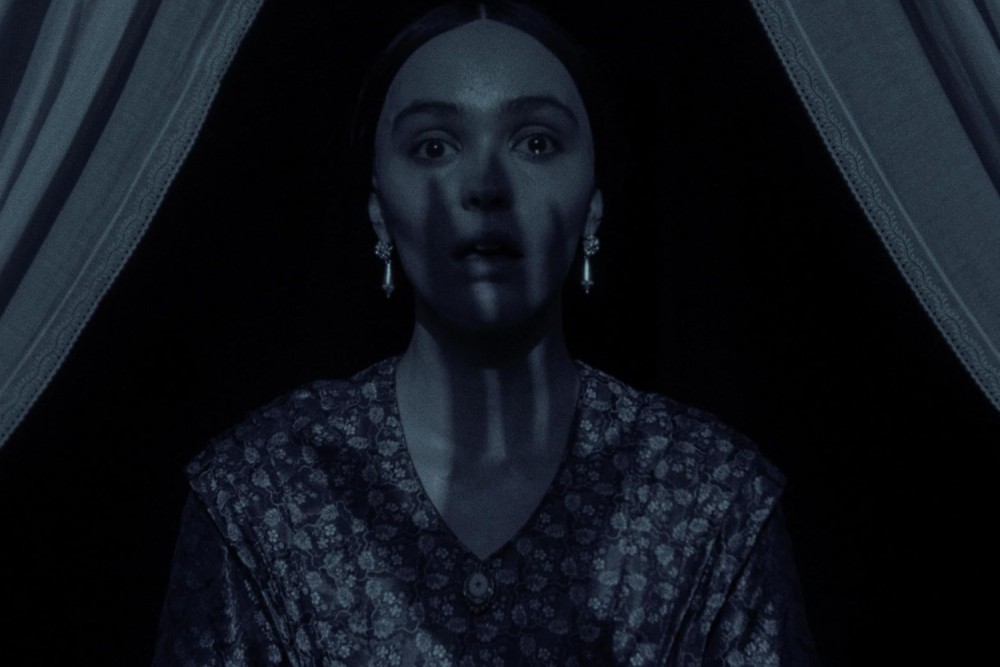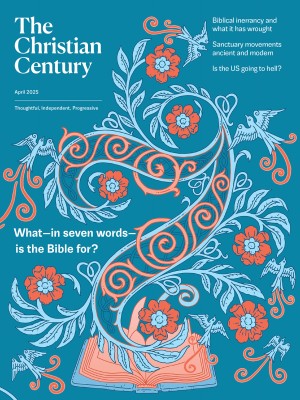Nosferatu and the horror of enlightenment
Robert Eggers’s film reminds us that much of what presents itself as common sense is just a contingent arrangement, one form of folklore instead of another.

Lily-Rose Depp in Nosferatu (Photo: Focus Features)
“Do you ever feel at times as if you’re not a person?” German woman Ellen Hutter (Lily-Rose Depp) says to her best friend Anna (Emma Corrin) in an early scene of Nosferatu (directed by Robert Eggers). “Someone or something,” she continues, “had the power to breathe life into you, to move you.” Anna has clearly never felt this way, and she looks both concerned and unsettled. Maybe, she suggests hopefully, this is the expansive love of God filling Ellen’s heart?
“What I wish to say,” Ellen explains, “is that you’re not truly present, nor alive, as if you’re at the whim of another, like a dog?” This is a theological bridge too far, and Anna quickly suggests they return home from their seaside walk, worried that Ellen is succumbing to another fit of hysteria and melancholy, like so many other sensitive 19th-century women.
Read our latest issue or browse back issues.
Ellen has been left with Anna and her husband, Friedrich (Aaron Taylor-Johnson), while her husband, Thomas (Nicholas Hoult), is sent to Transylvania to execute a real estate deed deep in the mountains with Count Orlok (Bill Skarsgård). Unfortunately for Ellen and everyone around her, her pure spirit, uniquely attuned to the spiritual currents of the world, has awoken the obsession of Nosferatu, the ancient vampiric form of Death itself, who abides in the count’s decaying body. It isn’t long before everyone around Ellen—and indeed most of the city—falls prey to his malevolence. Whether he can be stopped rests on the paradox Ellen feels in her soul: What kind of agency does she have against the boundless appetite of death?
Nosferatu is a remake of the 1922 German expressionist film by the same name, which was itself an unauthorized adaptation of Bram Stoker’s earlier novel Dracula. Eggers leans heavily into this earlier source material, probing for the folk mythologies that animated Stoker’s novel. His Nosferatu is dressed in the clothes of a 16th-century Hungarian nobleman; he speaks a reconstructed Dacian dialect; he sucks his blood directly from the chest, not the neck; nothing as paltry as garlic or silver can keep his evil at bay. He is the embodiment of primal nightmares and a repudiation of the glamorous vampire image that has prevailed since the vegetarian vampires of Twilight.
In each of Eggers’s films (Nosferatu is his fourth), he excavates historical worlds with excruciating attention to detail, reading obsessively in historical records and demanding fidelity down to the last shoe buckle and table fork. He creates worlds that are so perfectly realized we lose ourselves in them.
But this immersion serves a more expansive directorial vision: that of alienating us from our own reality. His movies are reminders that so much of what presents itself as common sense in our world is just a contingent arrangement, one form of folklore instead of another. We flinch at a vision of God’s sovereignty that clashes with our sentimental insistence that “everything will work out in the end” (The Witch). We struggle to understand a desire for revenge that exceeds any rational self-interest (The Northman). We are reminded that humans have been motivated by much darker psychological impulses than economic security (The Lighthouse). All the things we assume are good or right or obvious are called into question.
Given this vision, it is not surprising that he has named Nosferatu as a formative inspiration and why he has turned to it now. Stoker’s novel and the stories inspired by it, after all, are parables about how we came to be so deluded as to think we had mastered the art of living by denying the power of death.
The story is set in 1830, at the height of the Industrial Revolution. The main characters are from the new capitalist middle class, flush with money and obsessed with securing material comfort for their growing families. They make their living through new capitalist occupations like shipping, insurance, and real estate. When Thomas asks Count Orlok about the folk rituals he witnessed in the village—a group of Romani staking an undead corpse—the count deflects, explaining that Thomas comes from a “city of a modern mind that knows nothing of nor believes these morbid fairy tales.”
That, of course, is exactly the problem. Folk wisdom understands the evil Nosferatu embodies as the force of death itself, an appetite of destruction that exceeds any human ability to control it. Most of the German citizens have left such beliefs behind as the superstitious detritus of the unstoppable progress of modernity. They seek explanations for the chaos around them—Ellen’s fits, the plague of death Nosferatu unleashes, the slow unraveling of the human mind—anywhere except the obvious truth of evil.
The battle between good and evil, then, can’t be waged until a prior battle is settled, that between the ascending power of rational calculation and modern science and older forms of “alchemy, mystic philosophy, the occult”—represented by the character of Professor Albin Eberhart von Franz (Willem Dafoe). The content of these older forms of knowledge is pretty fuzzy. There are hints of an ancient Christianity engaged in spiritual warfare. The ritual that might defeat Nosferatu comes straight out of a fairy tale, but not the happily-ever-after kind. Ellen’s agency rests, unsurprisingly but somewhat lazily, in self-sacrifice. But you can’t be too picky about your solutions if you must spend all your time convincing people of the reality of the problem.
“We are not so enlightened as we are blinded by the gaseous light of science,” von Franz says to the disbelieving capitalists. “I have wrestled with the devil as Jacob wrestled the angel in Penuel, and I tell you that if we are to tame darkness, we must first face that it exists!” This is a fair summation of Eggers’s film—and maybe his approach to filmmaking. We are invited to look past our complacent certainties to other, stranger realities. What we see will likely terrify us.






